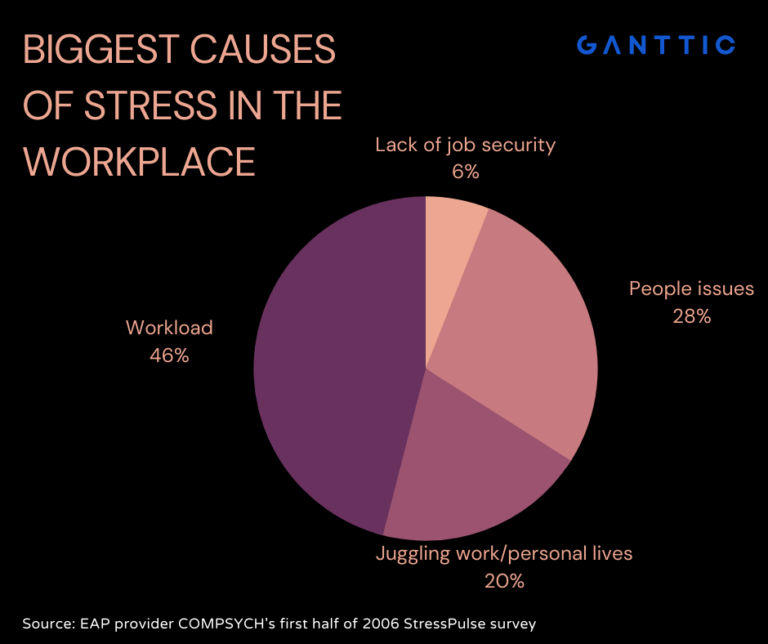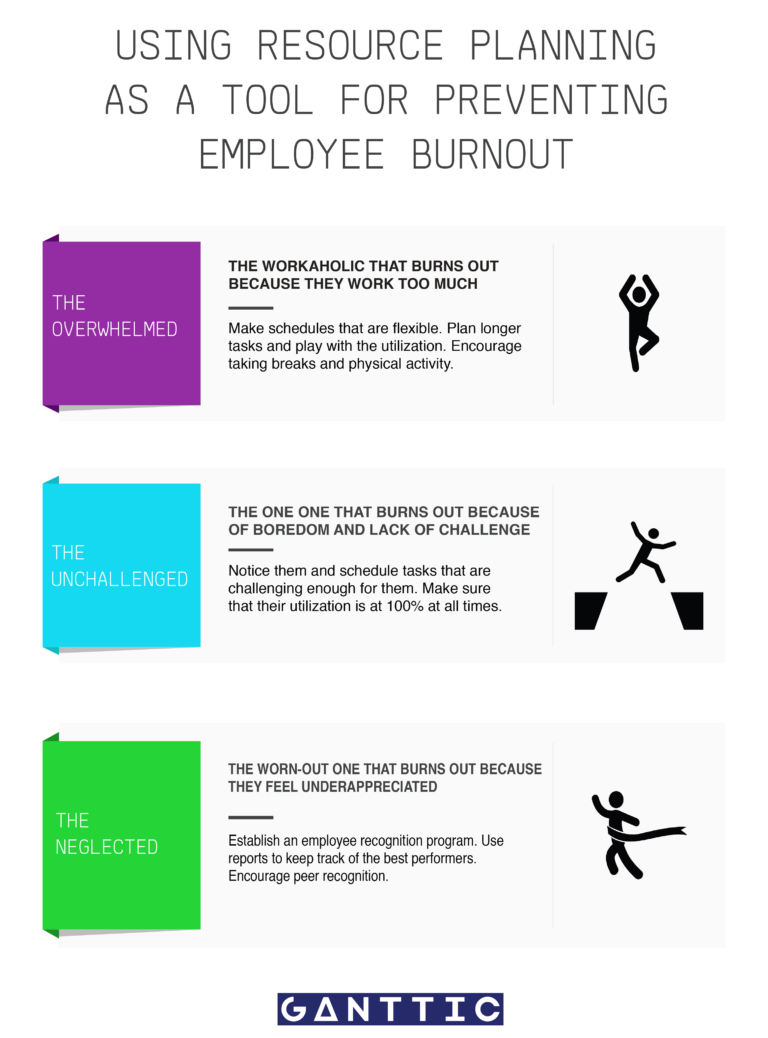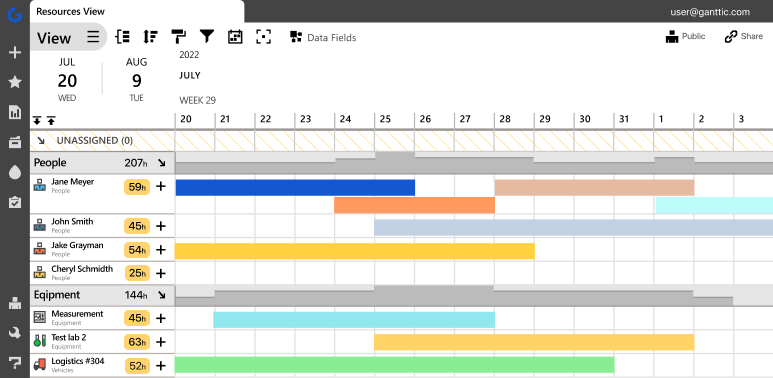Employees and human resources are crucial for smooth project delivery. Yet overloading your employees with more wrk than they can handle only leads to negative outcomes. To prevent employee overloading and the inevitable burnout that comes with it, it’s in everyone’s best interest to try and prevent it. Here we’ll highlight some telltale signs of employee overloading that you might see creeping onto your team. As well as a handy infographic on the type of employees who commonly experience it. Armed with this knowledge, you can begin providing a clearer path for your team’s wellbeing with some preventative scheduling methods.
What is Employee Overload?
Employee overload occurs when employees are given more tasks and responsibilities than they can reasonably handle within a given time frame. In a nutshell it is defined as emotional, mental, and even physical exhaustion due to work conditions. Employee overload and burnout are often used interchangeably, although more often than not, burnout is often a consequence of overloading staff.
Defining exactly how it looks is difficult, as it manifests differently for everybody. Although, it usually strikes after periods of prolonged stress. But what causes stress?
 Biggest causes of workplace burnout.
Biggest causes of workplace burnout.
Stress is brought on by an uneven workload (46%), human resource management issues (28%), work/life balance (20%), and uncertainty about job security (6%).
According to a 2018 Gallup poll, 23% of full time employees have reported feeling burnt out at work often or always. With another 44% admitted to feeling burnt out sometimes.
Most organizations wants the best out of their employees, and limiting employee overload is a great tactic for this. So project managers might want to start monitoring their team for the following signs.
Effect of Work Overload on Employees
Lately more workers than ever have been reporting feeling burnt out from their jobs and work responsibilities.
And remember, employee overload usually is not an individual problem. If one person on your team is experiencing it, it’s likely that other members are too. Which is all the more reason to squash it from spreading.
Here’s some of the most common signs of that you may start to notice amongst your employees and team:
- Irritability and frustration
- Indifference to work
- Anger and engaging in arguments
- Exhaustion
- Absenteeism
- Team Conflicts
What Industries are More Prone to Burnout?
Burnout can appear in any job and in any industry. Although not surprisingly, the higher the job stress, the more likely it is to manifest. The following industries run a slightly higher higher risk:
Healthcare & Social Work
Doctors, nurses, paramedics, and caregivers face long shifts, emotional strain, and life-or-death responsibilities. The other main cause for burnout in this profession is that doctors and nurses generally have long shifts, mixing patient care and administrative tasks. Similarily, mental health professionals and social workers deal with emotionally taxing cases and often have heavy caseloads.
Education
Teachers and professors face excessive workloads, lack of resources, and high expectations from students, parents, and administrators.
Tech & IT
Software developers, engineers, and cybersecurity experts deal with high-pressure environments, tight deadlines, and an always-on culture. Don’t let the office nap rooms and job perks fool you, IT professionals burn out a rapid speed
Finance & Banking
Investment bankers, accountants, and financial analysts work long hours, often in high-stakes environments where mistakes can be costly.
Law & Legal Services
Lawyers, paralegals, and public defenders face heavy caseloads, high-pressure cases, and unpredictable hours.
Construction & Manufacturing
Physically demanding work, safety risks, and tight deadlines contribute to burnout from these fields. The same goes not only for field workers, but for project and operations construction managers dealing with constant client demands, health and safety protocols, and keeping schedules on track.
Nonprofit & Activism
Employees in NGOs and advocacy roles often have high emotional investment in their work, low pay, and limited resources.
What Type of Employee Experiences Burnout?
According to a study published by BMC Public Health, there are three types of people that are more likely to burn out:
- First is the frenetic employee. This type of employee is driven by efficiency. This leads them to burn out because they are just too overwhelmed with their tasks. They are the people that you would call workaholics – those work and work until they exhaust their energy.
- The second is the under-challenged employee. There’s no mystery behind why they’ll burn out – their job just doesn’t have enough challenging aspects for them. Being bored can be just as stressful as overworking.
- The third is the worn-out employee. The worn-out type just feels neglected and under appreciated. They feel like they don’t have a grip on what’s going on and that’s what’s going to push them towards the burnout.

Now that you can recognize the signs of burnout and what type of employee it is most likely to manifest in, you’re on your way to quashing it in your team for good. Below we’ll give you some tips on how employee resource planning can help prevent burnout from showing up on your team in the first place.
Prevention is the Best Cure for Employee Overload
When your employees experience burnout not only does it affect them, but the results can be felt by everyone. From team members required to pick up slack. To the entire organization who then needs to deal with higher company-wide employee turnover and lower engagement. And last but not least it affects the team’s PM, who needs to schedule their way out of all the snafus that burnout creates.
If you’re a PM, you effectively dictate the schedules of your employees. Meaning you play a large role on your human resources’ mental wellbeing. And while burning out at your job can be brought on by numerous factors (including many you can’t control) there are still few things that you can do to prevent resource overload in project management.
5 Strategies To Prevent Employee Overload
This problem is not inevitable. And in fact there are some surefire ways to put a stop to the cycle for your staff. Here’s 5 ways to prevent your team members from burning out. As well as which software features to be on the lookout for.
1. Create a More Flexible Schedule
“All work and no play” usually leads to bad results. And human resource managers need to keep this in mind when they’re in the process of creating their resource schedules.
To mitigate that, favor scheduling longer tasks to the really short ones. For example, if you have multiple tasks that have to be done by Friday, schedule them as week-long concurrent tasks instead of trying to divide them between the days. That way the person can choose when they are working on which task. And can take breaks when needed.
Bonus Tip: Brake for Breaks
In addition to making a flexible schedule, encourage your team to take breaks. About a half of the employees in the US feel like they don’t have enough time to take breaks. And this has only been exasperated by the current trend of people working from home.
Having lunch while answering emails is not good practice. Neither is postponing a vacation due to the amount of work on your plate. Having too much stuff to do will translate into stress and that stress will translate to bad results.
Read On: Flexibility is the future of work. That’s why many companies are adopting a hybrid approach to the office. Read more about this latest work trend and how to implement hybrid elements into your projects, plans, and workplace.
2. Keep Employee Utilization at Optimal Levels
The number 1 reason for burnout is too of a high workload. So that should be the first thing you fix.
We don’t have those utilization percentages and capacity utilization graphs in our resource planning software for nothing. And they can come in handy when trying to schedule your team’s resources in a way that would prevent them from overworking and burnout.
After you have set your employees’ working hours, the percentage will show you the utilization of each resource in the period you have open in the Gantt chart area. If it’s over 100, make adjustments. In addition to that, you should make sure that what you think is optimal is actually optimal.
If you think a task should take X amount of time and it actually takes X+2 amounts of time, you are doing it wrong.
Just remember that overtime should be an exception, not the rule. If it your team keeps racking up the overtime, there’s some serious scheduling problems in play. Or you have a capacity problem.
Be on the Lookout for Resource Planning Software with Time Tracking:
Luckily for you, most resource planning software allows you to track the actual time (used time) spent on completing a task. Combine this info with the findings you discover with reports for even more insight. For example to see if you made a mistake in under- or over-estimating a task’s length. Something which can then be fixed it the next time around.
By using time tracking options you not only get a better picture of how much work your employees are actually doing, but you’re preventing them from being overloaded with their daily, weekly, or monthly tasks.
You can read about some more common resource utilization mistakes you might be making. And how to effectively quash them.
Tip: In Ganttic you can enter your Used time for tasks. Add in the amount of time as well as a description, date, and user info. This can also be integrated with a time tracker of your choosing with Ganttic’s API.
3. Recognize Employees for their Efforts

Recognizing those that deserve to be recognized boosts productivity. And is a fire extinguisher for those that tend to burn out because they feel under appreciated. Therefore, employee recognition gifts would be a great way to motivate employees and boost their productivity.
So if you want less tension in the office, fewer errors, and better customer service together with lower staff turnover, you need to recognize those that make the plans you make into reality one task at the time.
Be on the Lookout for Resource Planning Software with This Feature:
Reports aren’t only for reporting project progress to the upper management. Reports are also good for noticing the busiest bees in the team. Or establishing an employee recognition program. And encouraging peer recognition. Use them to help celebrate even the smallest victories!
4. Limit Multitasking
Unless you’re an expert juggler, multitasking is hard. It’s hard enough to concentrate on one task a lot of the time. So it’s only logical that multiple tasks are just about impossible.
When your team has to multitask they use a lot more brainpower. That equals a workforce that’s more exhausted mentally (and sometimes physically). And that’s a one way ticket to burnout. So whenever necessary, try not to encourage your team to engage in this practice too much.
And if you do, follow some of our tips on how to make multitasking work.
5. Schedule Challenging Tasks
Not only should you schedule the optimal amount of tasks, you should schedule tasks that are challenging. But just enough. As such, finding the right task and resource match is essential to preventing team burnout.
When employees have more challenging tasks they feel more productive. Productivity feeds into positivity. And soon you have a bustling workplace full of happier, more efficient employees. Sounds perfect, right?
Of course this can be challenging if many of your tasks are repetitive. But this is where a good human resource manager comes in. See who’s been working on what and change it up! Don’t keep giving the same task to the same teammate if you can help it. Scheduling the same tasks can be tempting, since they may make your job easier, but it might not always work to your benefit. Especially if it starts contributing to more team burnout.
Be on the Lookout for Resource Planning Software with This Feature:
Custom data fields are your best friends when looking to pair the right resource with the right task. Once you add specific and meaningful information to your resources, you can then filter and group according to these data fields.
Meaning if you have a project that requires a Spanish speaker or someone who has a knowledge of medieval roofs in England, you don’t have to guess. Nor do you have to waste time finding that info out. See more about using these data fields in conjunction with Views to better manage your workforce.
Help Your Team Burn Brighter, Not Burn Out

When you’re managing a team, it’s your duty to keep employee morale and wellbeing in mind. Doing so will not only makes the workplace more pleasant and productive, but it will help reduce turnover and ensure that you have happier, healthier human resources. Preventing resource overload in project management is the best thing you can do for your team. So is better resource management.
Sign up for a free demo and see how Ganttic can easily track your team’s utilization, so you can schedule employees smarter. And nip team burnout in the bud.